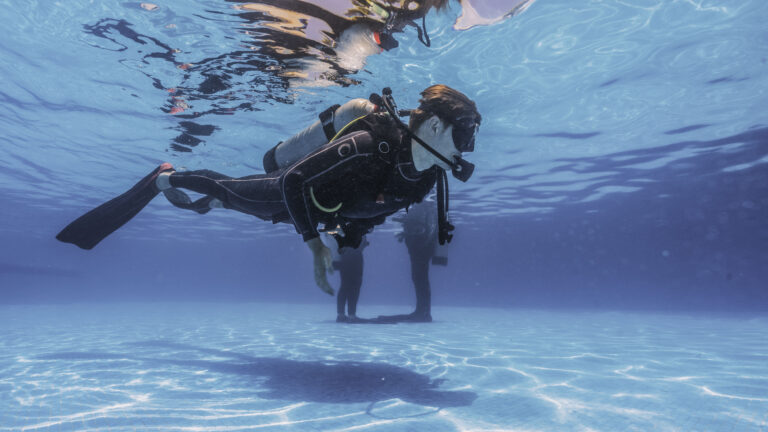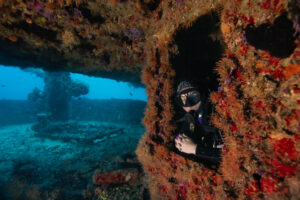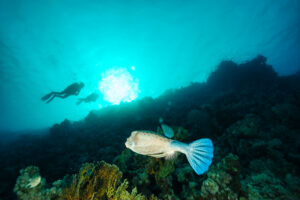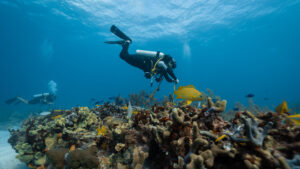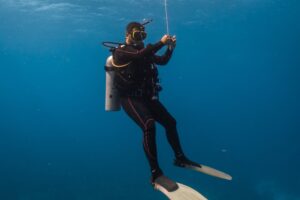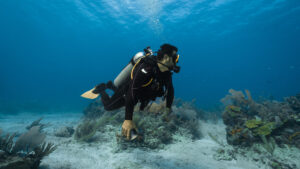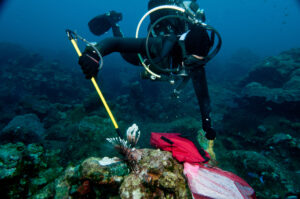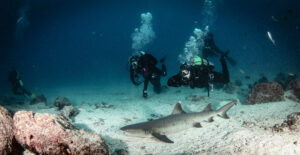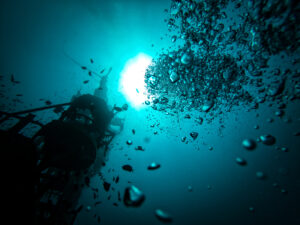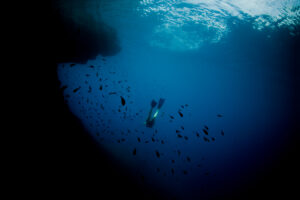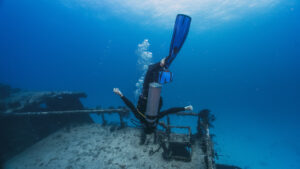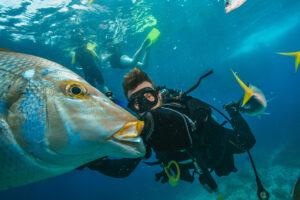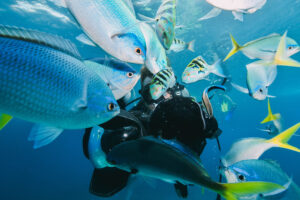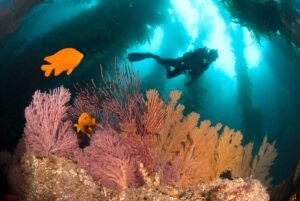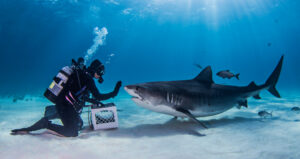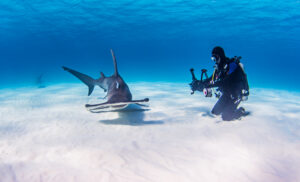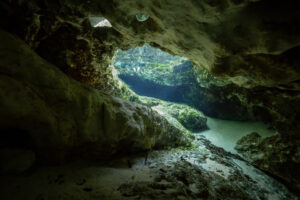What is the Professional Association of Diving Instructors (PADI)?
The Professional Association of Diving Instructors (PADI) is the world’s largest diving training organization, renowned for its comprehensive education system and certification programs. Founded in 1966, PADI has played a pivotal role in standardizing and enhancing diving training globally. With a mission to explore the underwater world safely and responsibly, PADI offers a wide range of courses that cater to beginners and experienced divers alike. Its extensive network of dive centers and professionals has made it a cornerstone of the diving industry, contributing significantly to the sport’s popularity and accessibility.
History of PADI
PADI was founded in 1966 by John Cronin, a scuba equipment salesman for U.S. Divers, and Ralph Erickson, an educator and avid diver. Their vision was to create a comprehensive training program that prioritized safety, standardized instruction, and made diving more accessible to the public. The early years saw PADI establishing foundational courses and materials that would become the cornerstone of its training system.
In the 1970s, PADI introduced the modular system of diver education, which allowed students to progress at their own pace through a series of steps or modules. This innovation was a significant departure from the more rigid training methods of the time and contributed to PADI’s rapid growth. By the end of the decade, PADI had established itself as a leading organization in the diving community, known for its quality instruction and comprehensive training materials.
The 1980s and 1990s were periods of significant expansion and innovation for PADI. The organization introduced new courses, including specialty diver courses and professional-level certifications. PADI also expanded its global reach, establishing offices and training centers worldwide. This period saw the launch of the PADI Instructor Development Course (IDC), which standardized instructor training and ensured that PADI instructors met high standards of teaching and safety.
Entering the new millennium, PADI continued to evolve, embracing technological advancements to enhance its training programs. The introduction of eLearning platforms allowed students to complete theoretical components of their courses online, making diving education more flexible and accessible. Throughout its history, PADI has remained committed to its mission of promoting safe and responsible diving practices, continuously adapting to the changing needs of the diving community.
Structure and Organization
PADI operates with a well-defined organizational structure designed to support its global operations and ensure the delivery of high-quality training programs. At the helm is the Executive Committee, responsible for strategic decision-making and overall governance. This committee includes the President and CEO, who provide leadership and direction to the organization.
Beneath the Executive Committee are several key departments that oversee various aspects of PADI’s operations. The Training and Education Department is central to PADI’s mission, responsible for developing and updating training materials and ensuring that all courses meet rigorous safety and quality standards. This department works closely with diving professionals and educational experts to create programs that are both comprehensive and accessible.
The Marketing and Communications Department plays a crucial role in promoting PADI’s courses and initiatives. By developing marketing strategies and campaigns, this department helps to raise awareness of PADI’s offerings and attract new divers. They also manage PADI’s online presence, including social media channels and the official website, which are vital tools for engaging with the global diving community.
PADI’s regional offices, located in key areas around the world, ensure that the organization can effectively serve its international members. These offices provide localized support and resources, helping dive centers and instructors maintain PADI’s high standards of training and customer service. Additionally, regional managers work to foster relationships with local stakeholders, including diving clubs, environmental organizations, and tourism bodies.
The organization’s structure is designed to support a decentralized model of operation, allowing individual dive centers and instructors a degree of autonomy while ensuring that they adhere to PADI’s standards. This approach has enabled PADI to maintain consistency in training quality across its global network, contributing to its reputation as a leader in diving education.
PADI Certification Levels
PADI offers a comprehensive range of certification levels designed to accommodate divers of all skill levels, from novices to seasoned professionals. The progression through these levels ensures that divers acquire the necessary skills and knowledge to participate safely and confidently in underwater activities.
The entry-level certification is the PADI Open Water Diver course, which introduces students to the basics of scuba diving. This course covers fundamental skills, such as equipment usage, underwater navigation, and buoyancy control. Upon completion, divers are certified to dive independently with a buddy to a maximum depth of 18 meters (60 feet).
For those seeking to enhance their skills, the PADI Advanced Open Water Diver course offers additional training and experience in different diving environments. This course includes five adventure dives, each focusing on a specific aspect of diving, such as deep diving, underwater photography, or night diving. The advanced certification allows divers to explore depths of up to 30 meters (100 feet).
The PADI Rescue Diver course is designed to develop a diver’s ability to handle emergencies and assist others in distress. This course emphasizes self-rescue techniques, recognizing and managing stress in other divers, and conducting effective rescue operations. The training includes both theoretical and practical components, preparing divers to respond to a variety of emergency situations.
At the professional level, the PADI Divemaster course is the first step toward a career in diving. Divemasters play a critical role in dive operations, assisting instructors, guiding dives, and ensuring diver safety. The course involves extensive training in dive leadership, supervision, and instructional techniques. Successful candidates become certified PADI Divemasters, authorized to oversee diving activities and support instructional programs.
For those aspiring to become diving instructors, the PADI Instructor Development Course (IDC) offers a comprehensive training program. The IDC prepares candidates to teach PADI courses, focusing on teaching methods, student assessment, and instructional skills. The course culminates in the Instructor Examination (IE), where candidates demonstrate their ability to conduct PADI courses effectively. Upon passing the IE, candidates are certified as PADI Open Water Scuba Instructors, authorized to teach and certify new divers.
PADI Training and Education System
The PADI training and education system is designed to provide divers with a structured, yet flexible, learning experience. Central to this system is the modular approach, which breaks down the training process into manageable segments, allowing students to progress at their own pace.
PADI courses typically consist of three main components: knowledge development, confined water training, and open water training. Knowledge development involves classroom or online learning, where students acquire theoretical knowledge about diving principles, safety procedures, and equipment. This component can be completed through traditional classroom sessions or via PADI’s eLearning platform, which provides interactive online courses.
Confined water training takes place in a swimming pool or shallow, controlled environment. During these sessions, students practice basic diving skills under the supervision of a PADI instructor. This hands-on training allows students to become familiar with their equipment and develop confidence in their abilities. Skills such as mask clearing, regulator recovery, and buoyancy control are practiced repeatedly until the student can perform them comfortably.
The final component, open water training, involves diving in a natural body of water, such as a lake, quarry, or ocean. Here, students apply the skills learned in confined water to real-world conditions. Under the guidance of an instructor, they complete a series of dives that assess their ability to perform essential skills and navigate underwater. Successful completion of this phase results in certification, allowing divers to explore the underwater environment independently.
PADI’s eLearning platform has revolutionized diving education by providing flexible, accessible learning options. Students can complete the knowledge development portion of their courses online at their own pace, using interactive modules that include videos, quizzes, and reading materials. This approach allows for a more personalized learning experience and enables students to spend more time practicing skills in the water.
The PADI system also emphasizes the importance of continuing education. Divers are encouraged to pursue additional training and specialty courses to expand their skills and knowledge. Specialty courses cover a wide range of topics, such as underwater photography, wreck diving, and marine conservation. By offering these courses, PADI ensures that divers can continue to grow and develop their abilities throughout their diving careers.
Global Reach and Influence
PADI’s influence extends far beyond its headquarters, with a global presence that spans over 186 countries and territories. This extensive reach is facilitated by a network of more than 6,600 dive centers and resorts, along with over 137,000 professional members who conduct training and certification programs worldwide.
The organization’s global presence is supported by regional offices located in key areas, including North America, Europe, Asia, and the Pacific. These offices provide localized support to dive centers and professionals, ensuring that PADI’s high standards of training and safety are maintained consistently around the world. They also facilitate communication between the central organization and its international members, addressing regional needs and concerns.
PADI’s partnerships and affiliations with various organizations have further cemented its influence in the diving industry. Collaborations with marine conservation groups, tourism boards, and diving federations have enabled PADI to promote safe and responsible diving practices on a global scale. These partnerships have also facilitated the development of conservation initiatives and educational programs aimed at protecting marine environments.
The impact of PADI’s training programs is evident in the widespread adoption of its standards and practices by the diving community. PADI’s emphasis on safety, quality instruction, and comprehensive training has set a benchmark for diving education. As a result, PADI-certified divers are recognized and respected worldwide, providing them with opportunities to dive and work in diverse environments.
PADI’s influence also extends to the tourism industry, where diving is a major attraction in many coastal and island destinations. By promoting high standards of training and safety, PADI has contributed to the growth of dive tourism, attracting enthusiasts from around the world. This, in turn, has supported local economies and encouraged the development of diving infrastructure in many regions.
The organization’s commitment to education and conservation has made it a leader in promoting sustainable diving practices. Through initiatives like Project AWARE, PADI has raised awareness about the importance
of marine conservation and engaged divers in efforts to protect underwater ecosystems. This global reach and influence have positioned PADI as a key player in the efforts to preserve the health and biodiversity of our oceans.
Environmental and Conservation Efforts
PADI has long recognized the importance of environmental stewardship and has made significant efforts to promote marine conservation. Central to these efforts is Project AWARE, a global movement founded by PADI to mobilize divers in the protection of the underwater environment. Project AWARE focuses on critical issues such as marine debris, endangered species, and coral reef conservation.
One of the key initiatives under Project AWARE is the Dive Against Debris program, which engages divers in removing and reporting underwater debris. This citizen science project not only helps to clean up marine environments but also provides valuable data on the types and quantities of debris found in different locations. The information collected is used to inform policies and actions aimed at reducing marine pollution.
PADI’s commitment to conservation is also reflected in its training programs. Environmental awareness and responsible diving practices are integral parts of PADI courses at all levels. From the Open Water Diver course to advanced and specialty courses, students are educated about the importance of protecting marine ecosystems and minimizing their impact on the environment. This emphasis on conservation helps to instill a sense of responsibility in divers, encouraging them to act as stewards of the underwater world.
In addition to Project AWARE, PADI collaborates with various environmental organizations to further its conservation goals. Partnerships with groups such as the World Wildlife Fund (WWF) and The Ocean Foundation have led to joint initiatives and campaigns aimed at protecting marine habitats and species. These collaborations have amplified PADI’s conservation efforts, bringing together resources and expertise from different sectors to address environmental challenges.
PADI’s efforts extend to raising awareness about marine conservation among the broader public. Through campaigns, educational materials, and social media, PADI highlights the importance of protecting our oceans and encourages individuals to take action. By leveraging its extensive network of divers and dive centers, PADI has been able to reach a wide audience and foster a culture of environmental responsibility within the diving community.
Member Benefits and Services
PADI offers a range of benefits and services to its members, supporting both recreational divers and professional instructors. These benefits are designed to enhance the diving experience, provide valuable resources, and foster a sense of community among PADI members.
For recreational divers, membership benefits include access to PADI’s extensive library of digital resources, such as training manuals, videos, and eLearning courses. These materials provide divers with ongoing education and support, helping them to stay informed about the latest diving techniques and safety practices. Members also receive subscriptions to PADI’s publications, such as the Undersea Journal and the PADI App, which offer news, tips, and features on various aspects of diving.
Professional members, including instructors and divemasters, enjoy additional benefits tailored to their needs. PADI provides professional liability insurance, which is essential for those conducting training and guiding diving activities. This insurance offers protection against potential legal claims, giving professionals peace of mind as they carry out their work. PADI also offers marketing and business support to dive centers and instructors, helping them to promote their services and attract new customers.
Another significant benefit for PADI members is the global recognition of PADI certifications. PADI-certified divers are respected and accepted at dive centers worldwide, providing them with opportunities to participate in diving activities in diverse locations. This global acceptance enhances the mobility and flexibility of PADI divers, allowing them to explore underwater environments across the globe.
PADI’s commitment to its members extends to providing ongoing support and professional development opportunities. The organization offers a range of continuing education courses and specialty certifications, enabling divers and instructors to expand their skills and knowledge. PADI also hosts events, workshops, and conferences where members can network, share experiences, and learn from industry experts.
Technological Innovations
PADI has embraced technological advancements to enhance its training programs and provide a more engaging learning experience for divers. One of the most significant innovations is the introduction of the PADI eLearning platform, which allows students to complete the theoretical components of their courses online. This platform includes interactive modules, videos, quizzes, and other digital resources that make learning more flexible and accessible.
The eLearning platform has revolutionized diving education by providing students with the convenience of studying at their own pace and in their own time. This flexibility is particularly beneficial for those with busy schedules or those who live far from dive centers. By completing the knowledge development portion online, students can focus more on practical skills during in-water training sessions, making the overall learning experience more efficient.
PADI has also leveraged technology to enhance the safety and enjoyment of diving. The introduction of digital dive logs and mobile apps has made it easier for divers to record and track their diving activities. These tools allow divers to log dives, monitor their progress, and share their experiences with others. The PADI App, for example, provides access to digital certification cards, dive planning tools, and a directory of PADI dive centers, making it a valuable resource for divers on the go.
Instructors and dive centers benefit from PADI’s technology-driven solutions as well. The PADI Pros’ Site offers a range of online tools and resources to support the training and management of students. Instructors can access teaching materials, track student progress, and communicate with their students through the platform. This streamlined approach enhances the efficiency and effectiveness of dive instruction, ensuring that students receive high-quality training.
Looking ahead, PADI continues to explore new technologies to further enhance its training programs and services. Virtual reality (VR) and augmented reality (AR) are among the emerging technologies that PADI is considering for future use. These technologies have the potential to provide immersive learning experiences, allowing students to practice skills in realistic virtual environments before entering the water.
Challenges and Criticisms
Despite its many achievements, PADI has faced several challenges and criticisms over the years. One common challenge is maintaining the consistency and quality of training across its vast global network. With thousands of instructors and dive centers operating independently, ensuring that all adhere to PADI’s standards can be difficult. PADI addresses this issue through regular audits, quality assurance programs, and continuous instructor training, but maintaining uniformity remains an ongoing effort.
Critics have also raised concerns about the commercialization of diving education. Some argue that PADI’s emphasis on expanding its market and offering a wide range of courses and specialties may sometimes prioritize profit over the quality of instruction. PADI counters this by emphasizing its commitment to safety and education, pointing to its rigorous standards and comprehensive training programs as evidence of its dedication to diver development.
Another area of criticism is the perceived environmental impact of diving. While PADI promotes responsible diving practices and conservation, the increase in the number of divers has raised concerns about the potential damage to delicate marine ecosystems. PADI has responded by strengthening its environmental education components and encouraging divers to participate in conservation activities. Initiatives like Project AWARE aim to mitigate these impacts by promoting sustainable diving practices and engaging the diving community in conservation efforts.
Safety is another critical area where PADI has faced scrutiny. Although PADI’s training programs emphasize safety, accidents and incidents can still occur. Critics argue that the relatively quick progression through certification levels may not provide sufficient experience for divers to handle challenging situations. PADI addresses these concerns by continually reviewing and updating its training standards, incorporating feedback from the diving community, and emphasizing the importance of continuing education and experience.
Future Prospects
The future for PADI looks promising, with numerous opportunities for growth and development. As the interest in diving continues to rise, PADI is well-positioned to expand its reach and influence further. Emerging trends in adventure tourism and increased awareness of marine conservation are likely to drive more people to seek diving experiences, providing PADI with opportunities to attract new divers.
Technological advancements will also play a crucial role in PADI’s future. The ongoing development of digital learning platforms and the potential integration of VR and AR technologies could revolutionize diving education, making it more engaging and accessible. These innovations will enable PADI to provide cutting-edge training programs that meet the evolving needs of the diving community.
PADI’s commitment to conservation will remain a central focus, with the organization likely to expand its environmental initiatives and partnerships. As the importance of protecting marine ecosystems becomes increasingly recognized, PADI’s role in promoting sustainable diving practices and conservation efforts will be more critical than ever.
Key Takeaways
The Professional Association of Diving Instructors (PADI) is a leading organization in diving education, known for its comprehensive training programs and global reach. Founded in 1966, PADI has significantly influenced the diving industry, promoting safety, quality instruction, and environmental conservation. With a commitment to innovation and continuous improvement, PADI remains at the forefront of diving education, providing divers with the skills and knowledge to explore underwater environments safely and responsibly. Through its extensive network and dedication to marine conservation, PADI continues to shape the future of the diving community.

